AUTUMN SUNSET
Ellen Mason captured this beautiful sunset from the village green in Stony Brook looking towards the harbor on Oct. 29. She writes, “What a glorious evening!”
Send your Photo of the Week to [email protected],
AUTUMN SUNSET
Ellen Mason captured this beautiful sunset from the village green in Stony Brook looking towards the harbor on Oct. 29. She writes, “What a glorious evening!”
Send your Photo of the Week to [email protected],
Ellen Mason, a volunteer at the Suffolk County Vanderbilt Museum in Centerport, has reported that Max, the Suffolk County Vanderbilt Museum cat who greeted visitors at the gatehouse for years, has passed away. Below is a poem she wrote in his honor.
Our Max, the Vanderbilt Cat
A sad day has fallen,
Enshrouded in gray.
Cherished and honored,
Our Max passed away.
Max was our mascot,
Our Vanderbilt cat.
He lived on the grounds,
But was much more than that.
He greeted our patrons
From his perch near the gate,
By the Vanderbilt gatehouse,
Entrance to this estate.
His special companion,
A guard here named Ed,
Brushed Max and loved him,
Making sure he was fed.
He bought Max a house
For those cold wintry days,
Where he snuggled inside,
Staring with his cat gaze.
Max lived life to the max,
Living up to his name.
For the guards at the gatehouse,
It just won’t be the same.
— By Ellen Mason, Stony Brook
The Suffolk County Vanderbilt Museum, 180 Little Neck Road, Centerport presents Storytime Under the Stars in the Charles and Helen Reichert Planetarium on Sunday, Aug. 27 from 6 to 7 p.m. Sponsored by Bank of America, Storytime evenings feature a live narrator at the front of the theater who reads from selected picture books, with pages projected onto the Planetarium dome so families can enjoy the illustrations and follow along. Between stories, an astronomy educator explores seasonal constellations visible from here on Long Island.
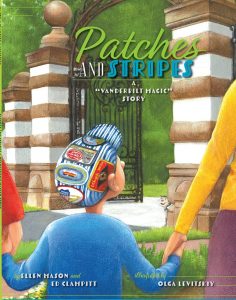 Author Ellen Mason will read her book, Patches and Stripes, one of four scheduled that evening. In it, she and co-author—and Vanderbilt Museum colleague—Ed Clampitt, tell the true story of a family that lost an heirloom during a Museum visit. That tale, in which the heirloom eventually “turned up,” is one the authors call “Vanderbilt magic.”
Author Ellen Mason will read her book, Patches and Stripes, one of four scheduled that evening. In it, she and co-author—and Vanderbilt Museum colleague—Ed Clampitt, tell the true story of a family that lost an heirloom during a Museum visit. That tale, in which the heirloom eventually “turned up,” is one the authors call “Vanderbilt magic.”
Mason, a Museum tour guide, and Clampitt, a member of the security staff, will do a book signing in the Planetarium lobby after the show.
All children are invited to wear their comfiest pajamas and bring their favorite stuffed animal. The admission fee is $8 per person and $6 for members. To reserve your spot, visit www.vanderbiltmuseum.org or pay at the door. For more information, call 631-864-5532.
BUSY BIRDS
Ellen Mason of Stony Brook sent this photo in on May 19. She writes, ‘A few weeks ago, a pair of Carolina wrens built a nest in a small gazebo on my porch. This photo captures feeding time. If you look closely, you will see baby’s open beak awaiting lunch. Bravo Mother Nature!
Send your Photo of the Week to [email protected]
By Ellen Mason, Stony Brook
The view from my window,
Looking out to the street,
Brings anticipation
Of deliveries complete.
From FedEx or postman
And sellers on eBay,
I await these small boxes
And how little they all weigh.
My mission accomplished
Might seem foolish to some,
But I’m filled with delight
By these parcels that come.
On eBay I found it,
And made it my mission:
To replace my old dollhouse,
Furnished bedroom to kitchen.
In primary colors
And precisely scaled detail,
This house from the fifties
Revives memories that were stale.
A complete living room,
Molded from plastic,
With couch and TV.
Just so fantastic!
A sewing machine,
A phone and a vacuum,
Have movable parts,
Like commode in the bathroom.
The biggest surprise
In daytime or night,
Is the Disney themed nursery,
Much to my delight.
Lithographed on the walls
And the yellow tin floor,
Are drawings of Mickey
And Donald and more.
A two-car garage
And second floor terrace
Complete the good life for
A suburban heiress.
I now have before me
My childhood dream,
Resurrected once more.
I give thanks to the team
Of sellers on eBay,
Of which there are many,
Who sell vintage stuff.
This was worth every penny.
If nostalgia now calls you
Then, at my behest,
Perhaps you will tune
Into “Father Knows Best.
Dollhouse from the Marx Toy Company, accessories from Marx and Renwal.
DRESSED FOR THE DAY
Tom Caruso of Smithtown sent in this incredible photo just in time for Valentine’s Day. He writes, ‘I recently installed a bird feeder in my backyard and I’ve been able to photograph some very beautiful birds. None is as beautiful as this male Northern Cardinal. This regal bird was taking a break from dining at my feeder when I snapped this picture. My camera was able to capture an amazing amount of detail in his feathers.’
By Ellen Mason, Stony Brook
A flash of brown and orange,
A dash of red and black,
The cardinals have returned.
I’m delighted that they’re back.
Nuts fall from the feeder,
The couple share a seed,
Then fly into my berry bush.
The male bird takes the lead.
He’s dressed in bright red plumage,
His eyes are sharp and bright.
He listens to the other birds
But keeps his mate in sight.
Chickadees and bluejays
Have mounted an attack.
Cardinals will not give an inch
And take the feeder back.
Have they come here for a reason?
With a message to impart?
Bringing solace, peace and comfort
To my sad and lonely heart?
Perhaps this is the moment
To reflect on life and love,
And thank the lovely cardinals
As they fly off high above.
Send your Photo of the Week to [email protected]
By Heidi Sutton
When Catherine and Anthony Hoang’s young son A.J. lost a family heirloom during a visit to the Suffolk County Vanderbilt Museum in the winter of 2017, the security staff, including Ed Clampitt, helped the Huntington family retrace their steps through the sprawling grounds and estate. The two-day search finally produced the precious object and became the inspiration for a new children’s book, Patches and Stripes: A ‘Vanderbilt Magic’ Story. Written by Clampitt and his fellow Vanderbilt Museum colleague and friend Ellen Mason, the beautiful 20-page book, told entirely in rhyme, features gorgeous illustrations by Olga Levitskiy. A book launch held at the museum in mid-October sold over 300 copies. I recently had an opportunity to speak to the two authors about their latest venture.
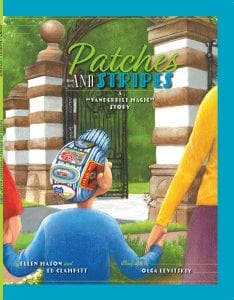 Ed, tell us when you first met the Hoang family and what did they lose?
Ed, tell us when you first met the Hoang family and what did they lose?
It was a very cold Sunday, around midday. I greeted the car as I do all our visitors. They explained to me that they had visited the day before and lost a hat. They inquired if one had been turned in to the lost and found. When I told them no hat had been turned in, they asked if it was OK if they searched the property themselves, revisiting all the areas where they had gone. Of course, I said yes and offered them a ride to the mansion where they would begin their search.
On the initial trip down, they explained to me the significance of the hat and how desperate they were to find it. I encountered them a few more times during the day and each time their despair became more evident. All I could do was offer them hope and reassure them that, if the hat was indeed on the property, we would find it. The hat was indeed found. I won’t give away the ending. To briefly sum it up, I will say that I was overcome with joy knowing we helped the family and their joy in getting back the hat was immeasurable.
Why was this hat so special to them?
EC: The hat was a precious heirloom passed down from previous family members, eventually coming to little A.J. The hat itself can best be described as a small engineer’s cap, a style from days past. It had blue and white stripes and was adorned with vintage patches depicting various railroad lines.
What inspired you to turn this true story into a children’s book?
EC: When I started to tell people the story and saw their reactions I knew it was a story that needed to be shared. When I shared the story with Ellen she immediately agreed and it fueled an inspiration in her that led to the book.
EM: After Ed told me the story of the hat, I wrote 10 stanzas of the poem fairly quickly. I just felt the story had the makings of a children’s book.
What parts of the museum are explored in the book?
EM: The security guards search for the hat in different areas of the museum. They start at the two eagles near the entrance, which originally stood at Grand Central Station in New York City. They proceed to the 6 ancient columns from Carthage that are 1000 years old. The mansion’s courtyard and iconic bell tower are beautifully illustrated as are the Habitat with the whaleshark. This lower museum was built in 1929 as a private museum for the entertainment of the Vanderbilt’s guests. The animal dioramas will remind visitors of those in the American Museum of Natural History in New York City.
How did the Hoang family react when they heard you were writing a book based on their experiences?
EC: My first contact with Catherine about our plans for the book were via email. From the very beginning she was extremely honored and excited.
When did the family get to see the book for the first time?
EC: I believe they saw the book for the very first time at the book launch (see page B26). Ellen and I did our best to keep it under wraps as long as possible!
Tell us about the illustrator, Olga Levitskiy. How did you three connect?
EC: Olga is an immensely talented young woman that currently resides in New Jersey. I’ve had the pleasure of working with her in the past on previous projects. When Ellen and I decided to go forward with the book my only stipulation was that we use Olga as our illustrator. Having never met Olga, Ellen put her trust in me and I’m sure she would agree it was the right decision.
Her illustrations perfectly capture what the museum looks like. What was her process like?
EC: After we contracted with her, Olga visited the museum grounds and took photographs of just about everything imaginable. While I can’t speak to the exact process I can say that she first did a preliminary story board based on the text. She then does each illustration in pencil and eventually colorizes them in watercolor and colored pencil. Each page becomes an original piece of artwork, much larger than the pages of the book. Suffice to say that once you see the illustrations in the book you can really appreciate the painstaking process it involved.
EM: When Olga visited the museum she came on my mansion tour. Unbeknownst to me, she photographed me in the courtyard and later included me in one of her illustrations.
How did you go about getting published?
EC: Having previous experience self publishing children’s books, I was familiar with process. We used a printer that I have worked with in the past as well. They are based in Ohio. Another part of the blessing working with Olga is that she handled all of the technical aspects of the job for us.
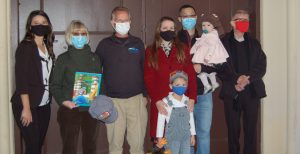
This is also a great way to introduce children to the Vanderbilt Museum, yes?
EC: Absolutely! From the beginning our hope was to have the book become an extension of the museum, a way of being able to take the property home with you. The intent was to have the story take you on a tour of the museum and the grounds.
EM: Yes, the book may elicit interest in visiting to see the actual sites and exhibits highlighted in the book and can also reinforce a previous visit as well.
EM: Many school groups and summer day camps visit yearly. There are plans to perhaps offer the book in birthday party packages booked at the museum.
What type of response has the book been getting?
EC: The response has been amazing! Everyone has been so impressed and supportive. We are so proud of the finished product. It represents the Vanderbilt well and has allowed us to realize our dream.
EM: The Vanderbilt staff is so appreciative of how the illustrations capture the smallest details of the architecture and exhibits. Ed and I feel especially proud that this is the only children’s book ever written about Eagle’s Nest and it includes Max the cat, who now basks in his fame at the gatehouse.
What message do you want children to take away from reading your book?
EC: On the forefront, the message is that the Vanderbilt is a true treasure, a place that we hope we inspire all to visit and continue to support. Additionally, it is a story of teamwork, hope and magic!
EM: The message is that there is value in studying history and the natural world; that one man’s life and generosity can enrich many other lives as well; and that goodness spreads; and the realization that all families have traditions that are important to them, sometimes symbolized by a treasured object.
Why do you think the Vanderbilt Museum is such a ‘magical’ place?
EC: Stories such as this one, the story that inspired the book, do not happen elsewhere. The place has an energy to it. It’s hard to explain. For those of us who are blessed to be able to work and spend time there, there is a love we share for the place … it makes you love it.
EM: I think it’s magical because of its romanticism — William K. Vanderbilt II built the estate out of love for his wife, Rosamond. The architecture and breathtaking setting that have been chosen by so many couples for their weddings.
Where can we pick up a copy of this book?
EC: Right now the books are sold exclusively in the Vanderbilt Museum’s gift shop. There will be the ability to purchase them online from the museum website soon. This entire project was intended as a donation to the Vanderbilt and proceeds go directly to benefit the museum.
Is there a recommended age group?
EC: I would say early readers but personally I am a big advocate of reading with a parent or as a family. I think this book is the perfect vehicle for that.
EM: Because the book is written as a 44 stanza poem, the musicality is suitable for younger children to be read to. Independent readers (grades 3 and 4) will pick up on the rhythm and rhyming pattern. I would love “Patches and Stripes” to inspire young readers to write their own poems showcasing a treasured possession.
Any more books on the horizon?
EM: One is already in the works, featuring Max the museum’s resident cat and his friend, security guard Ed. This one is also a narrative poem, like “Patches and Stripes.”
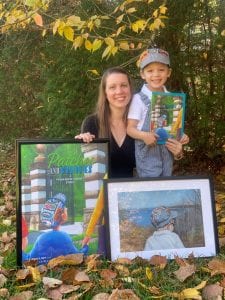
What advice would you give to someone who is thinking of writing a book?
EC: Write! Write! Write! If you have a story to tell, tell it! To write and create something that you can share with others is one of the most rewarding things you will ever do!
EM: My advice is to be patient. The process can move slowly, especially if illustrations are involved, but is well worth it. It never occurred to me to write any book, least of all one that rhymes. Yet here it is and I am so proud of it and grateful to Ed for suggesting that we collaborate on it. We present it as our gift to the Vanderbilt Museum for the many wonderful times it has given to us.
Anything else you would like to add?
EC: From the very beginning of all of this I have felt so strongly that this entire story, from the back story of the day the family visited, to the day we launched the book, is a story that needs to be told, from our point of view as well as the family’s. It is a story of how fate stepped in and changed lives … all for the better … how a simple visit to a local museum brought despair, then joy, validation, inspiration, pride and do much more … for the family, for Ellen and me and yes, even for the Vanderbilt … just a place, a piece of property devoid of feelings and emotions … unless you believe in magic.
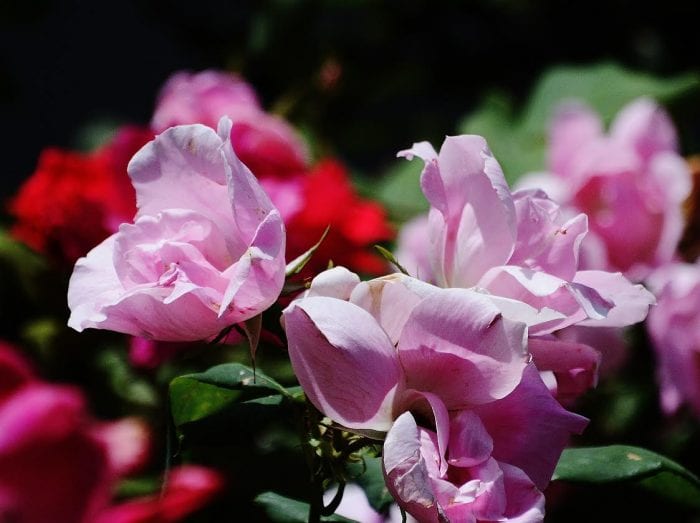
By Ellen Mason, Stony Brook
Civilization awakens.
The weather is warm.
We’re eager to mingle.
We’ve weathered the storm.
We’ve made such adjustments,
In the wish to resume.
Now it’s time for a haircut
And examining room.
We’re forever grateful
To workers out there,
Who stayed at their posts,
Through this horrible scare.
We welcome the changes
But with caution, at last
To face life in the future,
With somber thoughts of the
past.
By Ellen Mason, Stony Brook
Mother Nature is angry
And she’s showing her wrath.
We’ve destroyed her best efforts,
Walking down this wrong path.
Our health is at stake,
And the health of our earth.
But we’ve not done enough
To make up for this dearth.
Water pollution,
Severe climate change,
Endangered species,
There’s a whole range
Of needed improvements
For what we have wrought.
We’ve squandered our riches,
And look what we’ve bought!
Yes we’ll get through this,
She’s stern but not cruel.
But we must pay attention
And live by new rules.
Two friends on the staff of the Suffolk County Vanderbilt Museum in Centerport are engaged in a poetry-photo challenge. Their goal is to lift the spirits of their quarantined colleagues.
Ed Clampitt has been a member of the Museum’s security staff for four years. He challenged Ellen Mason, a volunteer tour guide for 14 years, to write poems inspired by his photos. Clampitt, who also has written some of the poems, likes to record seasonal beauty at Eagle’s Nest, the spectacular 43-acre Vanderbilt Estate that is also home to the Vanderbilt Museum and Reichert Planetarium.
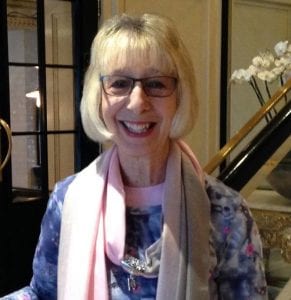
“During discussions about our upcoming children’s book, Ellen discovered her previously untapped talent for writing poetry,” Clampitt said. “I enjoy being her muse and inspiring that wonderful talent to blossom!”
Mason said, “Ed suggested that he take photographs at the Vanderbilt and challenged me to write poems to correspond to them. He surprises me with the photos and gives me no prior information. And I surprise him with the poems.”
Then the creative partners email the results to the Vanderbilt staff and members of the Board of Trustees. Their responses: delight and gratitude.
“It’s such a pleasure to receive their poems and photos,” said Elizabeth Wayland-Morgan, the Vanderbilt Museum’s interim executive director. “Ed and Ellen’s creations remind us of how lucky we are to work in such beautiful surroundings, especially now when we cannot physically be at Eagle’s Nest. Their pictures and words are inspiring.”

Clampitt, a Huntington resident who also has worked for Stop & Shop supermarkets for 40 years, is a front-line worker during the COVID-19 pandemic. He is also co-creator and author of Team Dawg, a character-education program and children’s book series that has been widely used in elementary schools throughout Long Island.
Mason, a Stony Brook resident and retired Centereach High School English teacher, leads tours of the Vanderbilt Mansion. She tells visitors stories about the Vanderbilt family and provides details on the Mansion’s architecture and centuries-old art and furnishings. During summer Living History tours, she and the guides dress in 1930s costumes to portray famous summer guests of Rosamond and William K. Vanderbilt II.
Here are two of Mason’s poems and one by Clampitt, with four of Clampitt’s photos taken on the Vanderbilt Estate:
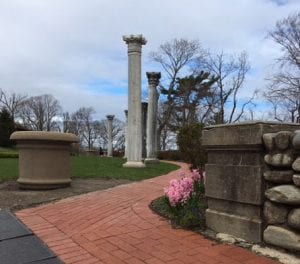
By Ellen Mason
Wrought iron gates / Now closed to us;
No sound of car / Or van or bus.
No children shout /Or laughter rings
Amid the trees /Where birds still sing.
The empty paths / And courtyard bare
Of visitors /A sight so rare.
A vista /Just around the bend,
Might give us hope / And chance to mend.
To breathe the air / At Eagle’s Nest,
Would lend our hearts / And souls some rest.
The day will come / When we’ll return,
To hug and share / Our lessons learned.
We’ll walk the paths / Blue sky above,
And celebrate / This place we love.
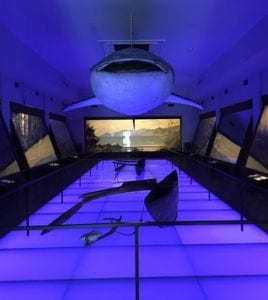 Night in the Museum
Night in the MuseumBy Ellen Mason
The grounds are dark, /And silence reigns;
No traffic noise / On roads or lanes.
No human sounds /Disturb the night,
As paths are bathed /In pale starlight.
Within the hushed /Exhibit halls,
Some species stir /On floors and walls.
With restlessness, /They shift and shake,
And move their eyes, /And try to make
Some sense of what / Has come to pass:
No students here / With friends and class,
In lines of two, / With cell phones poised,
They used to laugh /And make loud noise
Where are the folks, / The steady band,
Who climb the stairs / With map in hand?
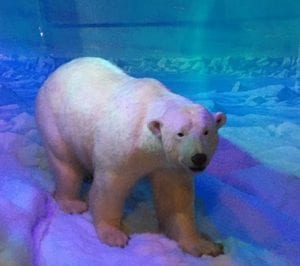 The whale shark swings / Both to and fro,
The whale shark swings / Both to and fro,
To catch the sight: / No one below.
The polar bear, / Now wide awake,
Believes there must be / Some mistake.
In the museum, / High on the hill,
In quiet rooms, / Alone and still,
The sharks, the eels, / The manatee,
Hang, waiting for /Humanity
Their vigil here, /Throughout the night,
Continues on / In morning light.
And so they wait, / And hope to learn,
Why we were gone, / When we return.
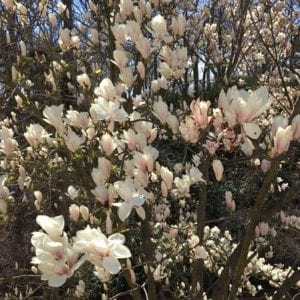 The Plan
The PlanBy Ed Clampitt
She’s still hard at work, / Preparing this place,
For the day coming soon, / When we meet face to face.
Each day brings new changes, /Some larger, some small,
She knows in her heart, /We feel blessed by them all.
Mother Nature the Wonder /Signs of hope that abound,
Just trust in her plan / What’s been lost will be found.
